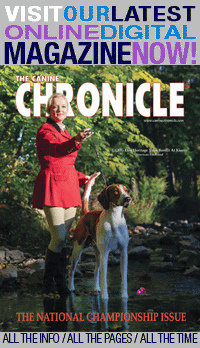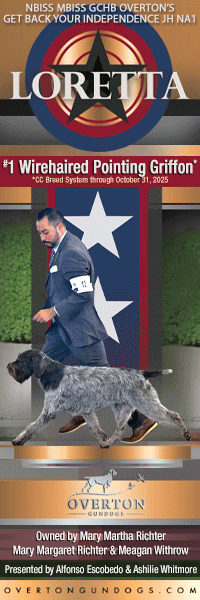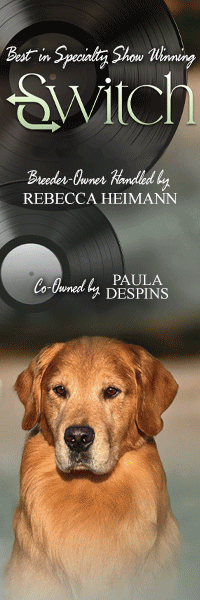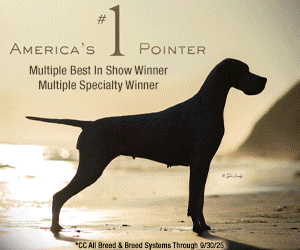The Rise of the King of All Terriers
Click here to read the complete article
By Amy Fernandez
 Today, every parent club grapples with their breed’s relative popularity. Positions at either end of the spectrum present substantial threats to overall genetic integrity. Managing this ongoing challenge/nightmare is tricky business but at least we have some signposts to achieve a happy middle ground. The Airedale’s fluctuating fortunes provided many of those insights. Recapping the ordeal for the ATCA 1960 Yearbook, Airedale breeder/former ATCA president Harold Florsheim said, “In 1925 Airedales reached their peak of popularity, but within a mere five years had slipped from their high point to a very low one.” That low rung on the ladder is never pleasant, but nothing hurts more than a sudden plunge from the top.
Today, every parent club grapples with their breed’s relative popularity. Positions at either end of the spectrum present substantial threats to overall genetic integrity. Managing this ongoing challenge/nightmare is tricky business but at least we have some signposts to achieve a happy middle ground. The Airedale’s fluctuating fortunes provided many of those insights. Recapping the ordeal for the ATCA 1960 Yearbook, Airedale breeder/former ATCA president Harold Florsheim said, “In 1925 Airedales reached their peak of popularity, but within a mere five years had slipped from their high point to a very low one.” That low rung on the ladder is never pleasant, but nothing hurts more than a sudden plunge from the top.
By the early 1920s, Airedales were firmly entrenched among AKC’s top ten breeds. Prominent owners like Warren Harding, Calvin Coolidge, John Jacob Astor, Ty Cobb, Theodore Roosevelt, and Woodrow Wilson kept the breed in the headlines. Barely 50 years earlier, Airedales came out of left field to capture Westminster three times within a decade. Top kennels existed from coast to coast, registrations flooded AKC, and champions finished at an impressive clip. Writing in 1919 R.M. Palmer proudly proclaimed, “For the past decade Airedale classes at all leading shows have taken their place among the principal breeds exhibited.” Westminster, among others, consistently drew over 100 Airedale entries.
Then, as quickly as this marvelous episode had unfurled, the Airedale crashed.
The Airedale’s initial rise certainly entailed dedication and struggle, but in comparison to most breeds, it was quick and complete. The breed’s dominance endured for over two decades and miscalculating its stability was understandable. In hindsight, the reds flags are unmistakable, but this was an entirely new phenomenon back then. It put Airedales at the forefront of a very tortuous learning curve.
After the breed’s third Westminster Best in 1922, demand skyrocketed. One California breeder, Dr. A.P. Deacon, reported selling 237 Airedales that year and he was not alone. However, a very significant percentage of this breeding was based on really great dogs. Airedales poured off the assembly line, but it was hard to go wrong when the gene pool overflowed with generations of ironclad quality; but nothing lasts forever. Other forces inevitably emerged.
Cutthroat competition is a powerful incentive to improve quality– and an equally strong motivation to seek shortcuts to the top. Things got nasty. Among others, Russell Johnson addressed this troubling issue rather bluntly in the ATCA Bulletin saying, “If you lose a tennis match you don’t jump across the net and beat your opponent over the head with your racket! In exhibiting dogs remember it’s a game. Its fun! Win or lose enjoy it!” That “keen, friendly rivalry” of 1915 gave way to factionalism, which rapidly undermined ATCA’s sustaining unity AND breed progress. But that wasn’t the only distressing repercussion as exhibitors jockeyed for that competitive edge.
No breed is immune from the enduring subplot of popularity. Feuding factions industriously promote tangential types, which in turn invites bad judging and unfocused breeding. This vicious cycle destabilizes type until it’s halted.
Predictably, size was a magnet for this nonsense. It had invited controversy from the start which initially triggered misguided efforts to shrink Airedales to more conventional terrier dimensions. However, the breed’s evolution was dictated by function, and in that respect, size was non-negotiable. “In 1880 the standard was published describing the breed, and it provided for dogs forty to fifty-five pounds and for bitches from thirty-five to fifty pounds. It was got up by Mr. Reginald Knight who was booming the breed and had dogs which ran over the generally accepted size. Mr. C.H. Mason was, at that time, the most prominent Yorkshireman in the show world, and he declined to sign Mr. Knight’s description because in his opinion no Airedale should be over forty-five pounds. Mr. Mason lived near Bradford, knew Airedales well and exhibited them, and the bulk of the fancy were of his opinion as to weight.”
Three years before Watson wrote this for The Dog Book, England’s Airedale club declared unequivocally that size mattered. “It is the unanimous opinion of the club that the size of the Airedale Terrier as given in the above standard (40-45 pounds) is one of, if not the most important, characteristics of the breed; all judges who shall henceforth adjudicate on the merits of the Airedale …failing to severely penalize or give prizes or otherwise push to the front, dogs of the small type shall at once be struck from the list of specialist judges.” A decade later Airedale size was running off the rails.
Emphasizing this defining aspect of type seemed a logical safeguard. It also graphically illustrated the unforeseen consequences of tweaking the standard. Later revisions eliminated weight requirements, but Airedale size bounced all over the map for decades. some big winners topped out at 24 inches and sixty pounds before the trend slowed. Massive and coarse or leggy and slabsided, they parodied that sturdy, athletic ideal.
Luckily, that could be fixed. Early Airedales sported every imaginable coat type. Imposing order on this shaggy brood was a matter of personal interpretation. For instance, the ATCA Yearbook described one prize winning import “shown here with her long, whitish neck hair parted down the middle and combed to each side of her neck resembling a Yorkshire Terrier.” It was a daunting job, but in the hands of experts like Percy Roberts and Len Brumby, the Airedale was transformed. In 1914 Robert Leighton pronounced it miraculous in Dogs and All About Them. He wrote, “There is perhaps no breed that has in so short a time been improved so much as the Airedale. He is now a very beautiful animal, whereas but a few years back, although maybe there were a few fairly nice specimens, by far the greater number were certainly the reverse of this. In place of the shaggy, soft coated, ugly colored brute with large hound ears and big round eyes, we now have a very handsome creature.” Proficient grooming gradually crossed the line into flagrant cheating to camouflage short heads, weak muzzles, fine bone, bad toplines, and those weren’t the only faults creeping into the breed.
Hard to believe, but Airedale attacks also became frequent and newsworthy. Unfortunately, they often involved children since the breed had a (mostly deserved) reputation as a great pet for kids. A 1924 headline story in Iowa’s Davenport Democrat described two small boys viciously attacked by an Airedale, ironically saved by their valiant Pit Bull. It wasn’t the first or the worst incident to make news. Back in the day when Charles Mason introduced the Airedale to America via the infamous Bruce, he went on record calling him the worst tempered dog he ever owned. Maybe his temperament wasn’t typical, but Bruce was a predominant sire. Thanks to scrupulous breeders, dodgy temperament was uncommon by the 1920s, but no amount of skillful selection eradicates that genetic card.
In 1925 AKC registered 3154 Airedales, less than half the 1920 total of 6386 which had earned the top ranking. By 1931 Airedale registrations hit a new low of 412. Some significant factors offset that harsh truth and encouraged beliefs that Airedales were rebounding to their former glory. Shelterock is best remembered for breaking the breed’s eleven year Westminster dry spell in 1933. As an Airedale lover and AKC advocate, Frederick Jones was doubly invested in restoring the breed’s status quo when he profiled Sheldon Stewart’s Montclair, New Jersey kennel a year later. “If Airedales had ever been away they certainly came back with a bang last year when Ch. Warland Protector of Shelterock proved himself such a grand showman,” he wrote.
His son, Am. Eng. Ch. Shelterock Merry Sovereign, was destined for an even more incredible career. He was exported to England on October 3, 1937, two days before AKC awarded him best American Bred Terrier of 1936. Sovereign’s quarantine ended September 10 and three weeks Bobby Barlow handled him to BIS, starting a career that made him the first American purebred to become a top English winner.
Shelterock’s success wasn’t the only development that suggested light at the end of the tunnel. Local all breed shows had long reaped the benefits of Philadelphia’s position as an Airedale stronghold. In 1926 Russell Johnson and James Manning decided to focus this resource into a Terrier group show which became Montgomery in 1929. From the start, it was designated as the Airedale National, making it an international showcase for the breed which was precisely what its founders envisioned when they launched the event. A year later Percy Roberts handled the import Ch. Flornell Tavern Maid to BIS for Montgomery charter member and VP, James F. Manning. The following year Len Brumby handled Fred Hoe’s Eng./Am Ch. Walnut Challenger to Group Third, returning to win it the next year. Brumby handled Shelterock Miss Sentiment, a Protector daughter, to Best in 1935. And in 1937 Percy Roberts took Montgomery with another Warland import, Watto of Oxon. “A win at Montgomery among ‘those in the know’ carries prestige exceeded in the east in terriers only by Westminster, Morris and Essex and the terrier specialty shows. No housepets or fillers at this show, but by the opposite token, few fliers missing.”As Popular Dogs noted in their review that year, Montgomery was primarily an east coast event. It offered a reassuring, but misleading, Airedale picture.
Throughout much of the country majors became scarce, type fragmented, and coherence dwindled along with ATCA membership, which contrasted sharply with overall trends in the dog world as the Brooklyn Daily Eagle reported December 16: “Purebred dogs appear to have run far ahead of the rest of the American sports ticket during 1937. Interest in man’s best friend never before reached such heights as it has during the past year, according to the AKC. With 18 clubs admitted, the total membership now stands at an all time high of 211. The number of bench shows increased to 317 from 302 and from coast to coast shows were marked by higher entries from 10 to 30 percent.” Reporting that registrations for AKC’s 107 breeds reached a new high, it was reported, “A decade ago, scarcely ten breeds could be termed important due to their total registrations. Today, nearly 20 are making a bid for general popularity” adding that Cocker registrations exceeded 14,000 that year, “this number is larger than that reached by any breed since the GSD reached 21,500 in 1926.”
Thanks to the surging post-war economy, legions of dog lovers suddenly possessed leisure time and disposable income to pursue a hobby they had known only as a spectator sport. The new wave of Airedale fanciers included talented individuals, but the vast majority of recruits were less so. These were hobby breeders and their Airedales were family pets. Their time, space and money limitations were compounded by a lack of communication and networking. Airedale fanciers had always been scattered throughout the country, but the old guard, the element of the club that kept the breed on track with its rather heavy handed guidance, was rapidly disappearing. Most were middle-aged or older during the breed’s Golden Years. The youngster of the group, Russell Johnson, succumbed to a heart attack in 1940, the only AKC president to die in office so far. They had facilitated the crucial networking which ensured that breeding programs weren’t derailed by faulty interpretations of type.
 Airedale numbers started climbing but quality and ATCA credibility took another hit. That wasn’t destined to change until ATCA redirected its focus. Only then could they start addressing the underlying obstacles holding the breed back, namely the sport’s widening generation gap, income gap, and knowledge gap. The new wave of Airedale breeders had boundless enthusiasm but they were novices in every respect, which Strong noted in her 1959 retrospective of these years.
Airedale numbers started climbing but quality and ATCA credibility took another hit. That wasn’t destined to change until ATCA redirected its focus. Only then could they start addressing the underlying obstacles holding the breed back, namely the sport’s widening generation gap, income gap, and knowledge gap. The new wave of Airedale breeders had boundless enthusiasm but they were novices in every respect, which Strong noted in her 1959 retrospective of these years.
“The interested puppy purchaser is a natural for club membership…but the objective of quality is overlooked. No knowledge of mathematics or genetics is needed to see where it leads. Bitch pups, good and bad, are sold with papers, bred, often haphazardly with the inevitable further downgrading of quality…It is squarely up to the breed clubs to maintain and improve the quality of their registered stock. Our present club method could perhaps be improved and the accent be transferred from more members and more litters to better litters.” Strong called it “a very difficult situation to untangle”. At that point, it was more like stopping a runaway train.
The club began reaching out to the many Airedale fanciers outside the ATCA through their Gazette column, utilizing the same formula that made the old ATCA Bulletins a key educational resource. Starting with the basics, ATCA reiterated and reinforced their message about type and quality. That success led to reviving the club newsletter, which was a major step in restoring cohesion within the fancy.
The answers began falling into place, but even those who sought quality had trouble finding it. Many of those elegant, gold-plated bloodlines died out along with the kennels that had nurtured them. Imports were America’s established source for quality Airedale stock. But modern breeders couldn’t rely on the likes of Bobby Barlow to scout for hidden gems. It didn’t matter, England’s ongoing weak economy, food rationing, and housing shortage kept Airedales in a holding pattern as Croxton Smith stated in his 1950 recap of British purebreds Dogs Since 1900: “Airedales, after enjoying a great vogue for a few years, seemed to have reached their zenith in 1925 with 5553 registrations at the Kennel Club; then for some mysterious reason there was a progressive decline in the number of registrations so that by 1932 they had fallen to 1787. At the close of the second war we had far more bad dogs than good.”
That didn’t deter diehards like Harold Florsheim. Reporting on a recent visit for the November 1946 Gazette, he noted, “The dog game in England is coming back slowly… I am sure that a year from today we will have outstanding Airedales in that country.” Florsheim’s search took somewhat longer, but it paid off.
Ch. Bengal Bahadur of Harham’s multiple ATCA specialty and all breed BIS wins from 1953-55 was the debut act. Eng. Am. Ch. Westhay Fiona of Harham arrived at a year of age in the fall of 1956. Handled by Tom Gately, she became the first Airedale to take a Westminster group since Protector back in 1933. She ended 1957 ranked fifth all breeds with 7 Best In Shows and 27 group wins. For 1958 she ranked second all breed with 17 BIS and 32 Group Firsts including Montgomery, setting a new record for Airedale top winners. Ch. Bengal Sabu arrived the next year. Also handled by Gately, his two year campaign yielded Best of Breed at 103 of 108 shows , 28 groups, 8 specialties and 7 Best In Shows. He also set a new top producer record siring 31 AKC champions.
Breeds have fallen in and out of favor throughout recorded history. However, the underlying implications of these trends were unrecognized until the advent of documented registration. Official recordkeeping invited the possibility of tracking progress and, as we know, numbers count. It’s also easy to overemphasize their importance, and of course they never tell the whole story of a breed’s stability. That realization was one of many insights gleaned from Airedale’s slow road to recovery.
Airedale popularity was never destined to return to its former level and the ATCA eventually let go of that meaningless goal. Strong put it nicely in 1959, “Everything points to a cresting wave of popularity for the Airedale and do let’s guard it well. Too great popularity has been the downfall of many breeds for commercialism crept in and in indiscriminate breeding brought deterioration of conformation, stamina and temperament. Lets bear in mind the good advice of our founders: In the chase for long heads, color or other craze, we lose sight of the fact that a good dog must be good all over.”
Of course, there was no magic formula to fix this mess. ATCA’s founders got it right the first time. They were fully engaged with the breed at that moment in time, not ruminating on its past or preoccupied with its future. Precisely the same game plan that had launched the Airedale’s initial supremacy eventually pulled it out of the lull.
Short URL: http://caninechronicle.com/?p=90650
Comments are closed











